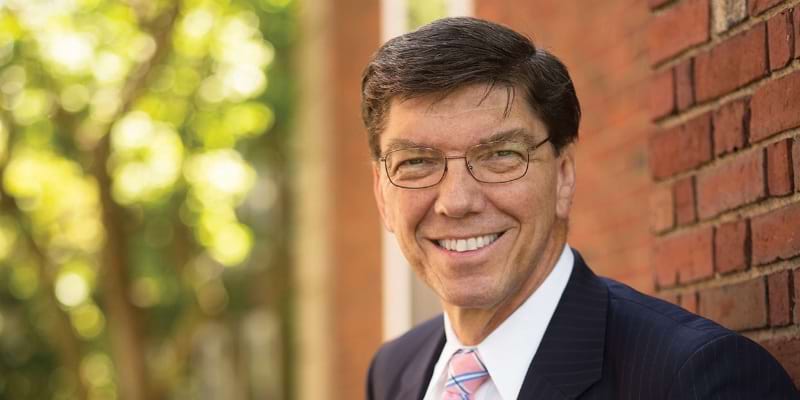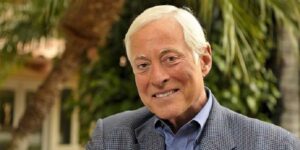Clayton Christensen biografie en quotes

Clayton Christensen (Clayton Magleby Christensen, 6 april 1952 – 23 januari 2020) was een bekende Amerikaanse wetenschapper en bedrijfsadviseur. Hij werd vooral bekend vanwege zijn theorie van disruptieve innovatie. Clayton Christensen was medeoprichter van Rose Park Advisors, een durfkapitaalfirma, en Innosight, een vooraanstaand adviesbureau op het gebied van innovatie. Zijn ideeën hebben een diepgaande invloed gehad op de zakenwereld en blijven inspiratie bieden voor verandering.
De biografie van Clayton Christensen
Clayton Christensen werd geboren in Salt Lake City, Utah. Hij was het tweede van acht kinderen van Robert M. Christensen en Verda Mae Christensen.
Jeugd en opleiding
Hij groeide op in de Rose Park buurt van Salt Lake City en volgde de West High School, waar hij studentenraadsvoorzitter was. Christensen en zijn broers en zussen werden opgevoed als leden van de LDS Kerk.
Als fanatiek basketballer van 2.03 meter lang, speelde hij als startende center in het mannenteam van de Universiteit van Oxford.
Na zijn afstuderen aan de middelbare school in 1970 werd Christensen geaccepteerd aan Harvard University, Yale University en Brigham Young University (BYU).
Na langdurig bidden en een duidelijk gevoel van inspiratie koos hij ervoor om naar BYU te gaan, waar hij een volledige studiebeurs had ontvangen.
Op BYU studeerde hij economie en volgde colleges met toekomstig Amerikaans presidentskandidaat Mitt Romney en toekomstig decaan van Harvard Business School, Kim B. Clark.
In 1971 vertrok Christensen voor twee jaar als voltijdse vrijwilliger op een zendingsreis voor de LDS Kerk naar Zuid-Korea. Hij leerde vloeiend Koreaans spreken en keerde terug naar BYU om zijn studie te hervatten. In 1975 behaalde hij zijn Bachelor of Arts-diploma met de hoogste onderscheiding in economie.
Na zijn afstuderen ontving hij een Rhodes Scholarship en studeerde hij twee jaar toegepaste econometrie aan Queen’s College van de Universiteit van Oxford, waar hij zijn M.Phil. behaalde.
Terug in de Verenigde Staten ging Christensen naar de Harvard Business School, waar hij in 1979 zijn MBA magna cum laude behaalde. Hij bouwde een indrukwekkende academische basis op en ontwikkelde zijn expertise in bedrijfsinnovatie en strategie.
Deze vroege periode van zijn leven legde de basis voor zijn latere carrière als invloedrijke academicus en consultant op het gebied van innovatie en disruptieve technologieën.
Loopbaan en ondernemerschap
Na het voltooien van zijn doctoraatsonderzoek trad Christensen in 1992 toe tot de faculteit van de Harvard Business School en bereikte in een tijd van zes jaar de functie van professor. Hij werd beroemd om zijn onderwijsstijl en onderzoek op het gebied van bedrijfsstrategie en innovatie.
In 2000 richtte hij Innosight LLC op, een advies- en trainingsbedrijf dat gespecialiseerd was in het begeleiden van bedrijven bij disruptieve innovatie. Drie jaar later werd hij medeoprichter van Ceramics Process Systems Corporation (nu CPS Technologies), een bedrijf dat geavanceerde keramiek produceert. Hij was tevens president en CEO van CPS Technologies in de late jaren 1980 voordat hij besloot een academische carrière na te streven.
Christensens invloed reikte verder dan lesgeven en advieswerk. Hij was medeoprichter van Innosight Ventures, een durfkapitaalfirma die zich richtte op investeringen in Azië, en Rose Park Advisors LLC, een investeringsmaatschappij die zijn onderzoek toepaste als beleggingsstrategie.
Gedurende zijn carrière bekleedde Christensen functies in de raden van bestuur van Tata Consultancy Services, Franklin Covey en het Becket Fund for Religious Liberty. Hij was een productieve schrijver en schreef tien boeken, waaronder zijn baanbrekende werk “The Innovator’s Dilemma”, dat de Global Business Book Award ontving.
Het concept en de theorie van disruptieve innovatie, dat in dit boek werd onderzocht, werd breed erkend en had veel invloed in de zakenwereld.
Christensen schreef ook over specifieke sectoren en behandelde maatschappelijke kwesties zoals onderwijs en gezondheidszorg in boeken als “Disrupting Class” en “The Innovator’s Prescription”. Hij ontving hiervoor lovende kritieken en talloze prijzen.
In 2017 deed Christensen een opmerkelijke voorspelling die veel aandacht trok. Hij voorspelde dat binnen de komende 10 tot 15 jaar ongeveer 50 procent van de hogescholen en universiteiten in de Verenigde Staten te maken zou krijgen met financiële uitdagingen die tot faillissement zouden leiden.
Gedurende zijn carrière heeft Clayton Christensen belangrijke bijdragen geleverd als professor, onderzoeker, consultant en auteur. Zijn ideeën en theorieën blijven het veld van het bedrijfsleven en de innovatie vormgeven en hebben een blijvende impact op hoe organisaties zich aanpassen en gedijen in een snel veranderende wereld.
Persoonlijke leven van Clayton Christensen
Christensen trouwde in 1976 met zijn vrouw Christine. Ze kregen samen drie zoons: Matthew, Michael en Spencer, en twee dochters, Ann en Catherine. Hun oudste zoon, Matthew Christensen was lid van het basketbalteam van de Duke University.
Als lid van de LDS Kerk diende Christensen van 1971 tot 1973 als zendeling in Korea, waar hij vloeiend Koreaans leerde spreken. Hij bekleedde verschillende leidinggevende functies in de kerk, waaronder die van bisschop.
Zijn boek “The Power of Everyday Missionaries” was een belangrijk werk binnen de LDS Kerk over hoe alle mensen betrokken kunnen zijn bij het delen van het evangelie, ongeacht hun positie in de kerk.
Hij was ook een drijvende kracht achter de totstandkoming van het boek “For All The Saints” van Kristen Smith Dayley, over de geschiedenis van de LDS Kerk in New England, dat in 2012 werd gepubliceerd en waarvoor Christensen het voorwoord schreef.
In februari 2010 werd bij Christensen folliculair lymfoom vastgesteld en in juli 2010 kreeg hij een beroerte waardoor zijn spraak beschadigd raakte en hij spraaktherapie moest ondergaan.
In 2011 publiceerde Christensen nog twee boeken: “The Innovative University” en “The Innovator’s DNA”.
Op 23 januari 2020 overleed Christensen op 67-jarige leeftijd aan de gevolgen van leukemie.
Bekende quotes
- “It’s easier to hold your principles 100 percent of the time than it is to hold them 98 percent of the time.”
- “Motivation is the catalyzing ingredient for every successful innovation. The same is true for learning.”
- “Because if the decisions you make about where you invest your blood, sweat, and tears are not consistent with the person you aspire to be, you’ll never become that person.”
- “Culture is a way of working together toward common goals that have been followed so frequently and so successfully that people don’t even think about trying to do things another way. If a culture has formed, people will autonomously do what they need to do to be successful.”
- “Decide what you stand for. And then stand for it all the time.”
- “Disruptive technologies typically enable new markets to emerge.”
- “Disruptive technology should be framed as a marketing challenge, not a technological one.”
- “First, disruptive products are simpler and cheaper; they generally promise lower margins, not greater profits. Second, disruptive technologies typically are first commercialized in emerging or insignificant markets. And third, leading firms’ most profitable customers generally don’t want, and indeed initially can’t use, products based on disruptive technologies.”
- “I don’t view it as mystic. I believe that God is our father. He created us. He is powerful because he knows everything. Therefore everything I learn that is true makes me more like my father in heaven. When science seems to contradict religion, then one, the other, or both are wrong, or incomplete. Truth is not incompatible with itself. When I benefit from science it’s actually not correct for me to say it resulted from science and not from God. They work in concert.”
- “I had thought the destination was what was important, but it turned out it was the journey.”
- “I used to think that if you cared for other people, you need to study sociology or something like it. But….I [have] concluded, if you want to help other people, be a manager. If done well, management is among the most noble of professions. You are in a position where you have eight or ten hours every day from every person who works for you. You have the opportunity to frame each person’s work so that, at the end of every day, your employees will go home feeling like Diana felt on her good day: living a life filled with motivators.”
- “If you defer investing your time and energy until you see that you need to, chances are it will already be too late.”
- “In contrast, investing time and energy in your relationship with your spouse and children typically doesn’t offer that same immediate sense of achievement. Kids misbehave every day. It’s really not until 20 years down the road that you can put your hands on your hips and say, ‘I raised a good son or a good daughter.’ You can neglect your relationship with your spouse, and on a day-to-day basis, it doesn’t seem as if things are deteriorating. People who are driven to excel have this unconscious propensity to underinvest in their families and overinvest in their careers—even though intimate and loving relationships with their families are the most powerful and enduring source of happiness.”
- “In fact, how you allocate your own resources can make your life turn out to be exactly as you hope or very different from what you intend.”
- “In order to really find happiness, you need to continue looking for opportunities that you believe are meaningful, in which you will be able to learn new things, to succeed, and be given more and more responsibility to shoulder.”
- “In our lives and in our careers, whether we are aware of it or not, we are constantly navigating a path by deciding between our deliberate strategies and the unanticipated alternatives that emerge.”
- “In your life, there are going to be constant demands for your time and attention. How are you going to decide which of those demands gets resources? The trap many people fall into is to allocate their time to whoever screams loudest, and their talent to whatever offers them the fastest reward. That’s a dangerous way to build a strategy.”
- “Indeed, while experiences and information can be good teachers, there are many times in life where we simply cannot afford to learn on the job. You don’t want to have to go through multiple marriages to learn how to be a good spouse. Or wait until your last child has grown to master parenthood. This is why theory can be so valuable: it can explain.”
- “Intimate, loving, and enduring relationships with our family and close friends will be among the sources of the deepest joy in our lives.”
- “Justification for infidelity and dishonesty in all their manifestations lies in the marginal cost economics of ‘just this once.”
- “People don’t want to buy a quarter-inch drill. They want a quarter-inch hole.”
- “Resisting the temptation whose logic was ‘In this extenuating circumstance, just this once, it’s OK’ has proven to be one of the most important decisions of my life. Why? My life has been one unending stream of extenuating circumstances. Had I crossed the line that one time, I would have done it over and over in the years that followed.”
- “Resources are what he uses to do it, processes are how he does it, and priorities are why he does it.”
- “The hot water that softens a carrot will harden an egg.”
- “The only metrics that will truly matter to my life are the individuals whom I have been able to help, one by one, to become better people.”
- “The only way to be truly satisfied is to do what you believe is great work. And the only way to do great work is to love what you do. If you haven’t found it yet, keep looking. Don’t settle. As with all matters of the heart, you’ll know when you find it.”
- “The reason is that good management itself was the root cause. Managers played the game the way it was supposed to be played. The very decision-making and resource-allocation processes that are key to the success of established companies are the very processes that reject disruptive technologies: listening carefully to customers; tracking competitors’ actions carefully; and investing resources to design and build higher-performance, higher-quality products that will yield greater profit. These are the reasons why great firms stumbled or failed when confronted with disruptive technological change.”
- “There are more than 9,000 billing codes for individual procedures and units of care. But there is not a single billing code for patient adherence or improvement, or for helping patients stay well.”
- “You can talk all you want about having a clear purpose and strategy for your life, but ultimately this means nothing if you are not investing the resources you have in a way that is consistent with your strategy. In the end, a strategy is nothing but good intentions unless it’s effectively implemented.”
- “The lesson I learned from this is that it’s easier to hold to your principles 100% of the time than it is to hold to them 98% of the time. If you give in to ‘just this once,’ based on a marginal cost analysis, as some of my former classmates have done, you’ll regret where you end up. You’ve got to define for yourself what you stand for and draw the line in a safe place.”
Publicaties en boeken van Clayton Christensen et al.
- 1992. Exploring the limits of the technology S‐curve. Part I: component technologies. Production and operations management, 1(4), 334-357.
- 1995. Disruptive technologies: catching the wave. Harvard business review, 73(1), 43-53.
- 1995. Explaining the attacker’s advantage: Technological paradigms, organizational dynamics, and the value network. Research policy, 24(2), 233-257.
- 1996. Customer power, strategic investment, and the failure of leading firms. Strategic management journal, 17(3), 197-218.
- 1998. Strategies for survival in fast-changing industries. Management science, 44(12-part-2), S207-S220.
- 2000. Meeting the challenge of disruptive change. Harvard business review, 78(2), 66-77.
- 2000. Will disruptive innovations cure health care?. Harvard business review, 78(5), 102-112.
- 2001. Competitive advantage. MIT sloan management review, 42(2), 105-109.
- 2001. Making friends with disruptive technology:‐an interview with Clayton M. Christensen. Strategy & Leadership, 29(2), 10-15.
- 2002. The great leap: Driving innovation from the base of the pyramid. MIT Sloan management review, 44(1), 51.
- 2004. Seeing what’s next: Using the theories of innovation to predict industry change. Harvard Business Press.
- 2006. Disruptive innovation for social change. Harvard business review, 84(12), 94.
- 2006. The ongoing process of building a theory of disruption. Journal of Product innovation management, 23(1), 39-55.
- 2008. Disruptive innovation in health care delivery: a framework for business-model innovation. Health affairs, 27(5), 1329-1335.
- 2008. Reinventing your business model. Harvard business review, 86(12), 50-59.
- 2008. Strategic management of technology and innovation. McGraw-Hill/Irwin.
- 2009. Disrupting Class: Disruptive Innovation Will Change the Way the World Learns. Education Review.
- 2009. The innovator’s prescription: a disruptive solution for health care. New York: McGraw-Hill.
- 2011. Managing disruption: an interview with Clayton Christensen. Research-Technology Management, 54(1), 11-17.
- 2011. The innovative university: Changing the DNA of higher education from the inside out. John Wiley & Sons.
- 2013. Is K-12 Blended Learning Disruptive? An Introduction to the Theory of Hybrids. Clayton Christensen Institute for Disruptive Innovation.
- 2013. Disruptive innovation. Brighton, MA, USA: Harvard Business Review.
- 2013. The innovator’s dilemma: when new technologies cause great firms to fail. Harvard Business Review Press.
- 2013. The innovator’s solution: Creating and sustaining successful growth. Harvard Business Review Press.
- 2016. The Innovator’s Dilemma: When New Technologies Cause Great Firms to Fail. Boston, Mass.: Harvard Business School Press.
- 2016. The Clayton M. Christensen reader. Harvard Business Review Press.
- 2018. Disruptive innovation: An intellectual history and directions for future research. Journal of management studies, 55(7), 1043-1078.
- 2019. The Innovator’s DNA, Updated, with a New Preface: Mastering the Five Skills of Disruptive Innovators. Harvard Business Press.
Citatie voor dit artikel:
Janse, B. (2023). Clayton Christensen. Retrieved [insert date] from Toolshero: https://www.toolshero.nl/bekende-auteurs/clayton-christensen/
Oorspronkelijke publicatiedatum: 07/08/2023 | Laatste update: 07/08/2023
Wilt u linken naar dit artikel, dat kan!
<a href=”https://www.toolshero.nl/bekende-auteurs/clayton-christensen/”>Toolshero: Clayton Christensen</a>












